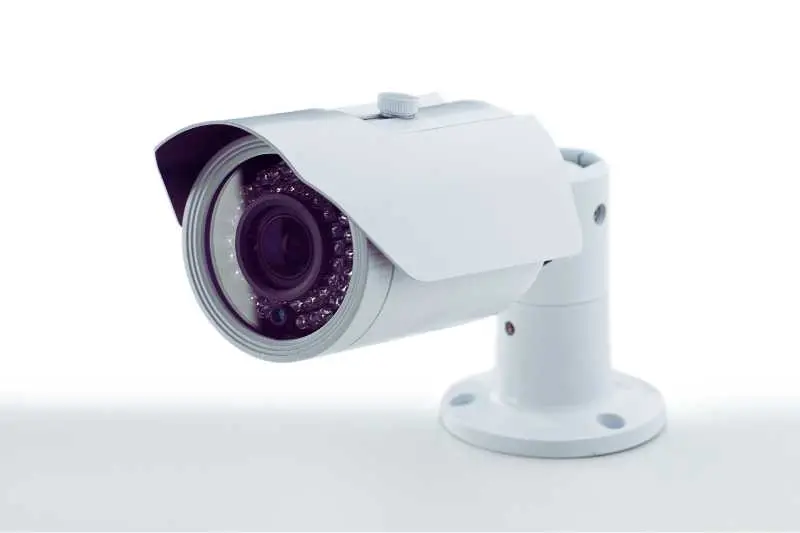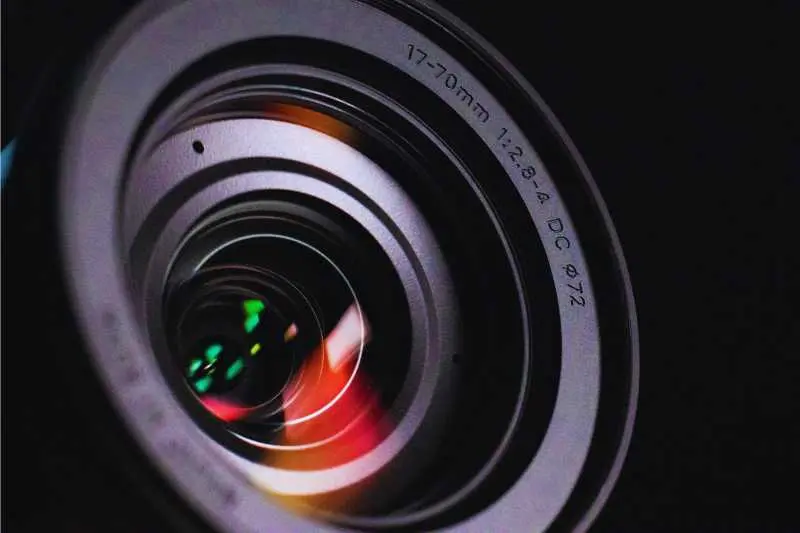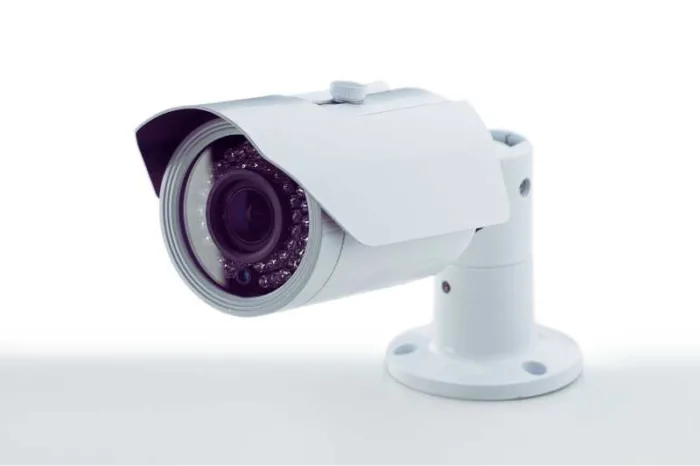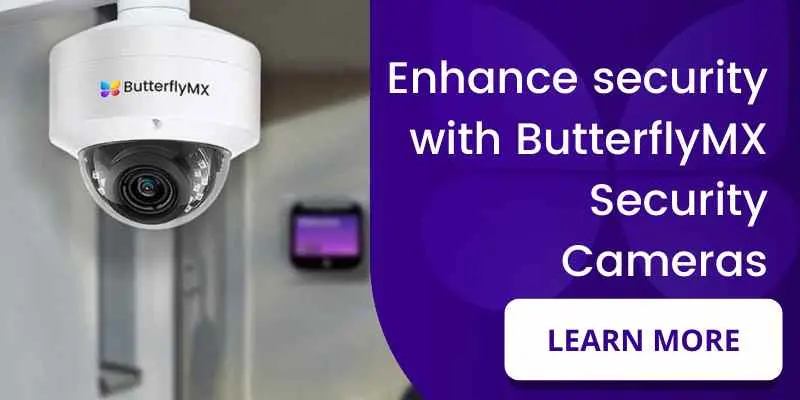Key takeaways:
- Bullet cameras are a sleek and narrow camera that resembles a bullet. It produces a clear and focused image with better zooming capabilities when compared to other cameras.
- The benefits of these cameras includes clear imaging, durability, and improved security.
- When installing your camera, make sure to pay attention to strategic placement, privacy laws, and maintenance needs.

With the rise of security camera technology, property managers are increasingly choosing between dome and bullet cameras to bolster their security measures. These are a popular camera type with a ton of different options to choose from.
In this post, we cover the best camera to buy. Next, we explore how these cameras work. Lastly, we determine how to install this camera best.
This post covers:
- The best bullet camera to buy
- What are bullet cameras?
- How do bullet cameras work?
- What are bullet cameras good for?
- How to use bullet cameras
- Bullet camera FAQ
The best bullet camera to buy
ButterflyMX is currently installed in over 15,000 buildings and has over 40,000 five-star reviews. Our camera also integrates seamlessly with our entire suite of access control products, including our Video Intercom, Elevator Controls, Package Room, and Vehicle Reader.
Our camera features:
- 24/7 HD surveillance. Unlike many other security cameras, ours provide continuous HD coverage around the clock, ensuring you capture every moment on your property. This can lead to valuable insights about how your property operates. Additionally, this can boost your property’s overall security.
- Cloud storage. Our Gateway stores recordings locally and then backs them up to the cloud. The ButterflyMX software subscription also keeps your footage accessible for up to seven days.
- Durability. Our indoor and outdoor cameras are encased in durable material that makes them resistant to inclement weather conditions.
- Simple installation. Our camera only requires a single Power over Ethernet (PoE) cable connected to Gateway, making setting up a breeze.
What are bullet cameras?
Bullet cameras are a type of surveillance camera characterized by their long, cylindrical shape, resembling a bullet. This distinctive design allows for straightforward installation and directional monitoring. Typically housed in a durable, weather-resistant casing, these cameras are well-suited for indoor and outdoor applications.
How do bullet cameras work?
Bullet cameras work by capturing video footage through their lens and image sensor. The captured footage is then transmitted to a recording device or network system for storage and monitoring. The modern version of these cameras often comes equipped with features such as infrared night vision, motion detection, and high-definition resolution, which enhance their effectiveness.
High-definition cameras can capture clear and detailed footage, making it easier to identify individuals and events. Resolutions can range from 720p to 4K. Equipped with infrared LEDs, these cameras can record clear video in low-light conditions, ensuring round-the-clock surveillance.
Additionally, most cameras include motion detection technology that alerts property managers to unusual activity, reducing the need for constant monitoring.
What are the components of a bullet camera system?
Bullet cameras generally consist of several key components:
- Lens. The lens focuses light onto the image sensor. It can be fixed or adjustable, providing varying levels of zoom and field of view.
- Image sensor. This converts the light into an electronic signal that is processed to create an image.
- Housing. The casing protects the camera’s internal components from environmental factors and tampering.
- Mounting bracket. Allows the camera to securely attach to a wall or ceiling, with adjustable angles for optimal coverage.

What are bullet cameras good for?
Next to dome cameras, a bullet camera is one of the best choices for your property.
Bullet cameras are good for:
Improved security
These cameras are an effective deterrent against criminal activity. Their visible presence alone can discourage potential intruders. For property managers, this means reduced risk of vandalism, theft, and unauthorized access.
Additionally, cameras can help residents feel safer. People are more likely to trust your building if they feel as though you’ve considered their safety, and nothing is more evident of that than security cameras.
Clear imaging
With high-resolution capabilities, these cameras offer sharp, detailed images crucial for identifying individuals and reviewing incidents. This clarity level is beneficial for investigative purposes and for maintaining accurate records.
If your cameras record in low quality, you won’t have much of an advantage if you ever have to review footage.
Versatility
These cameras can be mounted in various locations, including building exteriors, parking lots, and entryways. Their adjustable mounting brackets allow for flexibility in positioning, ensuring comprehensive coverage of critical areas.
A versatile camera is a more productive camera. You want a device that can cover your entire installation area.
Durability
Bullet cameras are renowned for their durability due to their robust, weather-resistant designs and sturdy materials. Typically encased in metal or high-grade plastic housings, these cameras are built to withstand harsh environmental conditions, including rain, dust, and extreme temperatures. Many feature reinforced lenses and seals to protect against physical damage and moisture ingress.
Additionally, their mounting brackets are designed to resist tampering and vibrations, ensuring the cameras remain securely positioned and functional over time.
How to use bullet cameras
The best way to use cameras is to pay close attention to the following:
1. Strategic placement
Cameras are only effective when you place them in the right spot. Improper coverage can create weak points in your property’s security.
When placing cameras, keep the following in mind:
- Entry and exit points. Install cameras at all main entry and exit points, including doors, gates, and driveways, to monitor access and egress.
- Perimeter surveillance. Position cameras along the property’s perimeter to detect any suspicious activity or potential breaches.
- High-traffic areas. Place cameras in high-traffic areas such as lobbies, hallways, and parking lots to capture critical interactions and movements.
2. Maintenance
To maintain optimal performance, regular maintenance of your camera is crucial. Clean the camera lenses periodically to prevent dust and dirt from obstructing the view. Check the alignment and functionality of each camera to ensure they are working correctly.
3. Integration
These cameras work best when integrated with other security systems, such as alarms and access control systems. This integration allows for a comprehensive security solution, enabling real-time alerts and coordinated incident response.
Learn how ButterflyMX works:
4. Remote monitoring
Modern cameras often have remote monitoring capabilities, allowing property managers to view live footage and receive alerts from anywhere via a smartphone or computer. Utilize these features to stay informed about the property’s security status and respond swiftly to any issues.
5. Privacy regulations
There are a lot of valid concerns for privacy when it comes to video surveillance. When deploying cameras, consider your state’s regulations and legal considerations. Ensure that cameras are not positioned in areas with a reasonable expectation of privacy, such as inside residential units or private offices. Adhering to legal standards helps prevent potential disputes and maintains tenant trust.
6. Data storage
Efficient data storage is essential for managing surveillance footage. Choose a suitable storage solution, whether on-site (e.g., network video recorders) or cloud-based, depending on the volume of footage and accessibility needs. Regularly review and archive footage to maintain a manageable and secure record-keeping system.

Bullet camera FAQ
- Can a bullet camera move?
- Do bullet cameras have audio?
- Why is a bullet camera called a bullet camera?
Can a bullet camera move?
Bullet cameras can be physically moved and adjusted, but most can not be remotely moved. A dome camera, on the other hand, can be remotely moved and positioned.
Do bullet cameras have audio?
It depends on the brand and model. In some cases, they can record audio and even enable two-way communication.
However, others don’t record audio or have speakers built within.
Why is a bullet camera called a bullet camera?
These cameras earn their name because of their distinct, compact shape that resembles a bullet.







